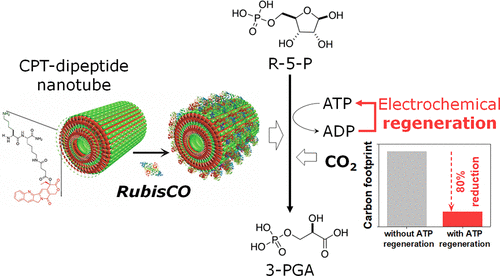当前位置:
X-MOL 学术
›
ACS Sustain. Chem. Eng.
›
论文详情
Our official English website, www.x-mol.net, welcomes your feedback! (Note: you will need to create a separate account there.)
Carbon Footprint of Biomimetic Carbon Fixation by Immobilizing Nature’s CO2-sequestering Enzyme and Regenerating Its Energy Carrier
ACS Sustainable Chemistry & Engineering ( IF 8.4 ) Pub Date : 2020-11-06 , DOI: 10.1021/acssuschemeng.0c05498 Kyuha Lee 1 , J. Parker Evans 2 , Sriram Satagopan 3 , Yuan Sun 4 , Jon R. Parquette 4 , Vishnu Baba Sundaresan 2 , F. Robert Tabita 3 , Bhavik R. Bakshi 1
ACS Sustainable Chemistry & Engineering ( IF 8.4 ) Pub Date : 2020-11-06 , DOI: 10.1021/acssuschemeng.0c05498 Kyuha Lee 1 , J. Parker Evans 2 , Sriram Satagopan 3 , Yuan Sun 4 , Jon R. Parquette 4 , Vishnu Baba Sundaresan 2 , F. Robert Tabita 3 , Bhavik R. Bakshi 1
Affiliation

|
In the Calvin cycle of photosynthesis, ribulose-1,5-bisphosphate carboxylase/oxygenase (RubisCO) catalyzes the conversion of ribulose 1,5-bisphosphate to 3-phosphoglyceric acid (3-PGA) while incorporating atmospheric CO2 into an organic molecule. Thus, RubisCO is nature’s CO2-sequestering enzyme that is present in chloroplasts. As an effort to mitigate climate change, biomimetic carbon fixation technologies have been developed through RubisCO immobilization into nanostructures to form nanostructure–RubisCO complexes. The technologies mimic the plant cellular environment’s ability to convert CO2 into higher-value products. In this work, a carbon footprint of 3-PGA produced through carbon fixation by the complexes is investigated using the LCA approach. Serine, an amino acid for pharmaceutical applications, is identified as a potential product from 3-PGA. Hotspot processes in terms of the carbon footprint are identified to suggest potential improvements for emerging technologies. Conducting LCA for emerging technologies has many challenges. A sensitivity analysis is performed for uncertain data, and the adenosine triphosphate (ATP) preparation process for the 3-PGA production is identified as a hotspot inventory. We identify that the carbon footprint to produce 3-PGA can be significantly lowered by integrating carbon fixation technologies with an electrochemical ATP regeneration technology.
中文翻译:

通过固定自然界的CO 2-螯合酶并再生其能量载体来仿生碳固定的碳足迹。
在光合作用的卡尔文循环中,核糖-1,5-双磷酸羧化酶/加氧酶(RubisCO)催化核糖1,5-双磷酸转化为3-磷酸甘油酸(3-PGA),同时将大气中的CO 2掺入有机分子中。因此,RubisCO是存在于叶绿体中的自然界中的CO 2-酯酶。为了缓解气候变化,通过将RubisCO固定在纳米结构中形成纳米结构-RubisCO复合物,开发了仿生碳固定技术。这些技术模仿了植物细胞环境转化CO 2的能力成为高价值的产品。在这项工作中,使用LCA方法研究了复合物通过碳固定产生的3-PGA的碳足迹。丝氨酸是一种用于制药的氨基酸,被确定为3-PGA的潜在产物。确定了碳足迹方面的热点过程,以建议新兴技术的潜在改进。对新兴技术进行LCA挑战很多。对不确定的数据执行敏感性分析,并将3-PGA生产中的三磷酸腺苷(ATP)制备过程确定为热点清单。我们发现,通过将碳固定技术与电化学ATP再生技术相结合,可以显着降低生产3-PGA的碳足迹。
更新日期:2020-11-16
中文翻译:

通过固定自然界的CO 2-螯合酶并再生其能量载体来仿生碳固定的碳足迹。
在光合作用的卡尔文循环中,核糖-1,5-双磷酸羧化酶/加氧酶(RubisCO)催化核糖1,5-双磷酸转化为3-磷酸甘油酸(3-PGA),同时将大气中的CO 2掺入有机分子中。因此,RubisCO是存在于叶绿体中的自然界中的CO 2-酯酶。为了缓解气候变化,通过将RubisCO固定在纳米结构中形成纳米结构-RubisCO复合物,开发了仿生碳固定技术。这些技术模仿了植物细胞环境转化CO 2的能力成为高价值的产品。在这项工作中,使用LCA方法研究了复合物通过碳固定产生的3-PGA的碳足迹。丝氨酸是一种用于制药的氨基酸,被确定为3-PGA的潜在产物。确定了碳足迹方面的热点过程,以建议新兴技术的潜在改进。对新兴技术进行LCA挑战很多。对不确定的数据执行敏感性分析,并将3-PGA生产中的三磷酸腺苷(ATP)制备过程确定为热点清单。我们发现,通过将碳固定技术与电化学ATP再生技术相结合,可以显着降低生产3-PGA的碳足迹。



























 京公网安备 11010802027423号
京公网安备 11010802027423号